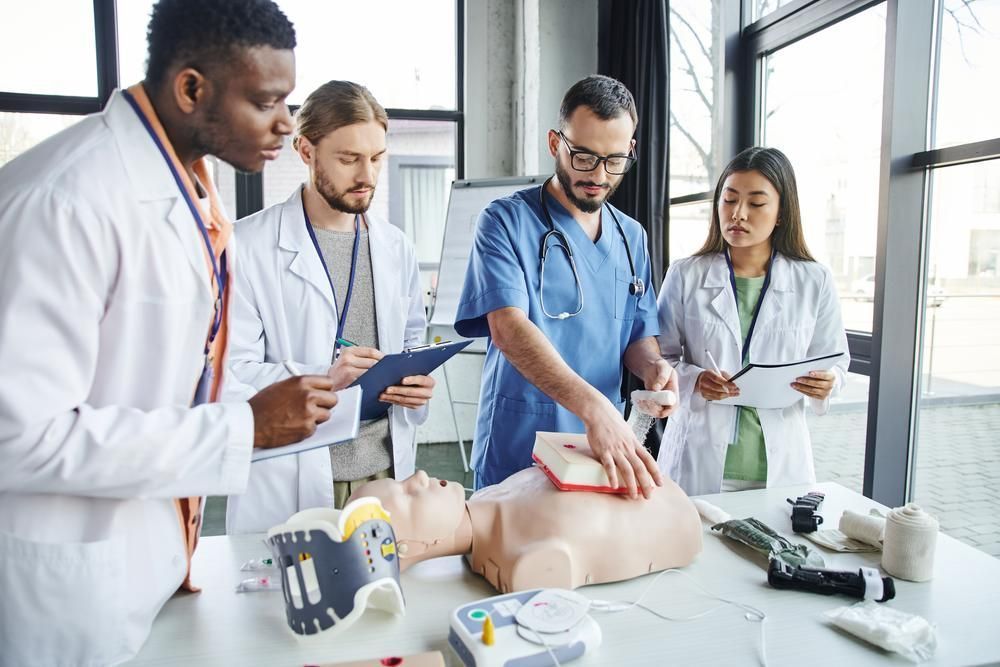How to Fill-in for the Role of Clinical Simulation Technician
The clinical simulation technician is an incredibly valuable and at times underrated member of clinical simulation teams. A clinical simulation technician often is in the background of clinical simulation courses; to make sure that all the little things are taken care of and a smoothly run healthcare simulation course ensues. A clinical simulation technician is an expert who problem solves any issues as they arise in a clinical simulation course. For another member of the clinical simulation team to step into this role; a lot is at stake. This article by Erin Carn-Bennett, RN, MSN will discuss suggestions and tips for a clinical simulation team member to step into the incredibly valuable role of a Sim Tech when being a clinical simulation technician is not the usual role of the individual.
Policies and Procedures Can be Incredibly Helpful in Orientation
There may or may not be organizational and healthcare simulation team policies and procedures to assist internal or external healthcare simulation staff to step into the clinical simulation technician role as a temporary measure. If the step into the role is planned to cover vacations or other pre planned leave; there may be time before the leave where the clinical simulation technician can prepare for the absence. The preparation may include the write up of documents of any relevant technical set up and problem solving that may be of assistance for occurrences in the clinical simulation technician’s absence.
Sponsored Content:
All clinical simulation team members should be upskilled to the role of healthcare simulation technician. This role is highly skilled technically in regards to the maintenance and running of manikins and other technological interfaces utilized in clinical simulation teams and organizations. Not only should all team members be upskilled into this role incase of requirement due to clinical simulation technician absence; but practice of these skills should be maintained on a regular basis in order to avoid skill decay.
Be Sure to Take Time to Schedule Practice Time for The Whole Clinical Simulation Team
Regular and scheduled sessions should be in the clinical simulation programs team calendar to have the clinical simulation team be coached by the clinical simulation technician. In these scheduled sessions with the clinical simulation technician the schedule should include practice of manikin set up, problem solving of issues with support and also daily operation and management. This will also assist to ensure that all clinical simulation team members practice is current in regards to the clinical simulation technician role. This is important as the healthcare simulation technician role has constant alterations and upgrades to practice. (as technology evolves and improves)
View theHealthySimulation.comLEARN CE/CME Platform Webinar Troubleshoot, Repair and Optimize the Life Expectancy of Clinical Patient Simulators to learn more!
Sponsored Content:
Choose to demonstrate lifelong learner capabilities by a choice to learn about new clinical simulation products as they arrive into the clinical simulation program or organization. Work alongside sales representatives and the clinical simulation technician to learn as much as possible about how clinical simulation technology and manikins work. This can pay dividends when attempting to problem solve technological issues when the healthcare simulation technician is not present. With a depth to understand prior to issues that occur under time pressure; pre existing knowledge can be incredibly beneficial.
Increase individual and clinical simulation teams knowledge base about the clinical simulation technicians role by participation in online forums and courses of note for clinical simulation technicians which are either in person or online. This can also provide a network of support as required whilst in the fill in of the clinical simulation role. Some of these include: “Simulation Technician Network” private group on facebook, STEP (Simulation Technician Education Program) courses by Laerdal, individual support networks and courses provided by companies that provide manikins and other healthcare simulation based courses, (such as CAE currently known as Elevate Healthcare) SimGHOSTS online courses and University based course programs.
As a team member who will fill in the clinical simulation technician role there is a need to be organized early and learn about the common errors that can happen with manikins and clinical simulation technology. Know how to problem solve issues as they arise and pay a lot of attention into this process during scheduled practice time and also in everyday clinical simulation scenarios. Observe how the clinical simulation technician problem solves any manikin or technology based issues and ask questions to broaden knowledge bases.
Have a Plan for What to Do if Things Don’t go to Plan
If possible have a clinical simulation technician on call to contact if unable to resolve any issues during courses run in their absence. If this is not an option, then consider other options of on call assistance that may be available incase of any technology emergencies. A support person who is knowledgeable about the clinical simulation technician role and manikins can be a great peace of mind for any staff who are a fill in for the clinical simulation technician role. This support may even potentially be able to be provided by the manikin or technology company which has supplied the products. The best option is to ask and be over prepared, than to be underprepared.
Sometimes no matter how much preparation and practice has happened, errors, mistakes and failures can occur. The clinical simulation technician role and responsibilities are often much more complex than appears on a surface level. Learn from any errors or mistakes and move forward in practice. Reflect on what went well and what to do differently next time alongside the rest of the clinical simulation team. Make sense of anything that went wrong within this practice and make peace with this.
This article has discussed the concept of how to be a fill in clinical simulation technician. The clinical simulation technician role is an integral, complicated and highly skilled member of the clinical simulation team. All members of a clinical simulation team should be orientated and upskilled into the role of a healthcare simulation technician role. The process to be orientated and also to maintain skills within the healthcare simulation technician role is continuous.
The healthcare simulation technician is an often invisible yet incredibly important role which is critical to the smooth running of any clinical simulation course. A clinical simulation technician is an expert at problem solving technological issues under pressure. Although the ability to fill in or replace this role at short notice is not easy, there are many steps that clinical simulation programs can take to ensure resilience within their healthcare simulation programs for when this is required.
7 Tips for Healthcare Simulation Techs
Erin Carn-Bennett is a Simulation Nurse Educator for the Douglas Starship Simulation Programme in Auckland, New Zealand. Carn-Bennett has her Masters of Nursing and has an extensive nursing career within pediatric emergency and also nursing management. She is passionate about debriefing and all things simulation. Carn-Bennett is a member of the IPSS board of directors. Carn-Bennett is the lead host of the podcast Sim Nurse NZ.
Sponsored Content:


















